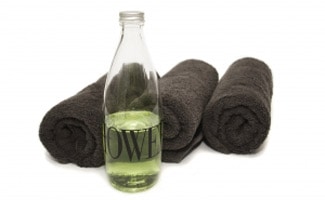How to Make Natural Shampoo
 Here at Earth’s Friends we like to emphasize how important it is to pay attention not only to what you put in your body, but what you put on it. Why? Because your skin is sensitive, and chemicals that come in contact with it will absorb into your body.
Here at Earth’s Friends we like to emphasize how important it is to pay attention not only to what you put in your body, but what you put on it. Why? Because your skin is sensitive, and chemicals that come in contact with it will absorb into your body.
If You Can’t Read It, Leave It!
That being said, have you ever checked out some of the ingredients on your favorite shampoo? On the outside it may talk all about fruits and herbs, but on the inside those fruit and herb aromas might be created chemically – at least in part if not in full. As a rule of thumb, if you don’t know what the ingredient on any product is (food or non-food), chances are it’s not natural. If you can’t pronounce it, chances are even better that it’s a chemical.
Don’t Listen to the Ads!
It’s ironic how manufacturers of shampoo will put so much time and effort (and advertising money) into marketing their shampoo – showing girls jumping through flowery fields and yelping with excitement as their foamy creation touches their hair. The truth is, if you knew what was inside your shampoo – you’d be yelping too.
Mass Market Shampoos Contain Chemicals
Just about any mass marketed shampoo (ie. those in your local grocery store, and especially those for which you see ads on TV and in print) is going to contain chemicals. Why? Because it lowers the manufacturing cost significantly, and as far as health regulations go, unfortunately they’re allowed.
Some of the most common toxic chemicals found in shampoo are:
- Cetearyl alcohol – an emulsifier that comes in both synthetic and natural forms.
- Isopropyl alcohol – used as a cheap solvent to carry synthetic oils.
- Methylparaben – a synthetic preservative
- Propylparaben – another type of synthetic preservative
- Propylene Glycol or simply Glycol– an inexpensive petrochemical
- Distearate – a type of glycol
How to Make Natural Shampoo
The key to a natural shampoo is the base ingredients. Once you’ve got these stocked and are comfortable using and mixing them, your home made shampoos will get progressively better in quality, and you’ll find yourself experimenting with different textures and scents.
Natural Shampoo Ingredients
What’s your best way around these chemicals? It may sound daunting, but it’s actually not that difficult. The most affordable way to keep your hair and body healthy and clean is to make your own shampoo. There’s natural shampoo’s on the market, but they tend to be excessively expensive.
The following ingredients are the foundation for most natural shampoos:
- Four ounces of castile soap (choose a plain soap, or a scent you like, such as peppermint or eucalyptus).
- Half an ounce of lavender – lavender helps control sebaceous oil production, which will help reduce itchiness and flakiness.
- Half an ounce of nettles – nettles not only contain nutrients that contribute to hair growth, they also purify and stimulate blood.
- Half an ounce of rosemary – rosemary will help prevent premature baldness by stimulating hair follicles.
- Half an ounce of sage – sage is not only a good source of antioxidants, but it acts as an antibacterial agent and will prevent spoilage. Look at it as a natural preservative.
- 2000 milligrams of MSM – MSM (MethylSulfonylMethane) is an organic sulfur compound that will not only make your hair healthier, but stronger – by feeding your skin and hair follicles with herbal nutrients. It comes in liquid, cream, gel, powder, and capsule form. Consult your doctor before using MSM, especially if you are using medications.
- An empty plastic bottle (eight ounces) – you can use an existing shampoo bottle if you wish.
Creating Your Own Natural Shampoo
Once you have all your shampoo ingredients lined up, creating the actual shampoo is not that difficult. Start by combining all the herbs in a jar. Next, boil two cups of water, and then add three tablespoons of your herbal mixture to the water. Take it off the heat and let it sit for thirty minutes. Once it has cooled down, add the MSM and strain the mixture into a bowl. Finally, combine the mixture with two cups of herbal tea in the plastic bottle and add the castile soap. Shake it up and you’re ready to enjoy your home made natural shampoo 🙂
Variations on Your Natural Shampoo
Now that you have the basics down, you can play around with different herbs, paying attention to their health and nutritional properties – to come up with a shampoo that is suited to your scalp and hair needs. You’ll feel good no matter what knowing you’ve created a natural, additive and toxin free shampoo that your body (& hair) loves! Below are some examples of natural shampoo variations you can try.
Chamomile Shampoo
Chamomile shampoo is a popular homemade shampoo that not only smells good, but makes you feel good as well. It’s best suited for oily hair types. Just think of how comforting chamomile tea is – those properties can be transferred and used in your shampoo as well. You’ll need the following ingredients to make chamomile shampoo:
- Four chamomile tea bags
- Four tablespoons of pure soap flakes
- One and a half tablespoons of glycerin
Boil a couple cups of the chamomile tea, add the soap flakes, and mix in the glycerin. Shake it up and let it cool down.
Soapwart Shampoo
Soapwart shampoo is another popular variation of natural shampoo. The ingredients are as follows:
- Two cups of distilled water
- Two teaspoons of soapwart root
- Two tablespoons of lemon verbena (if you can’t find lemon verbena, you can also use catnip)
Simply bring the water to a boil, add the soapwart, and simmer the mixture for twenty minutes. Next, remove from heat, add the lemon verbena, and allow to cool. Mix it all up in a bottle and you’ve got homemade soapwart shampoo.
Select Your Herbs Based on Your Hair Type
If you’re trying to figure out what herbs to use, let your hair and scalp be your guide. For oily hair, it’s best to use Burdock, Lemongrass, Nettle, Peppermint, Rosemary, Sage, Spearmint, and Tea Tree. If your hair is dry, on the other hand, you’ll want to use Calendula, Chamomile, Elder flowers, Lavender, or Sandalwood.
Experiment around with your own natural shampoo creations and share your results by commenting below!
Shelf Life of Natural Shampoos
It’s important to note that the shelf life of natural shampoos is significantly less than that of chemical-based shampoos. That’s because natural shampoos are made of organic ingredients that decompose over time. You’ll want to be especially careful with the soapwart shampoo, and use it within ten days of bottling.



